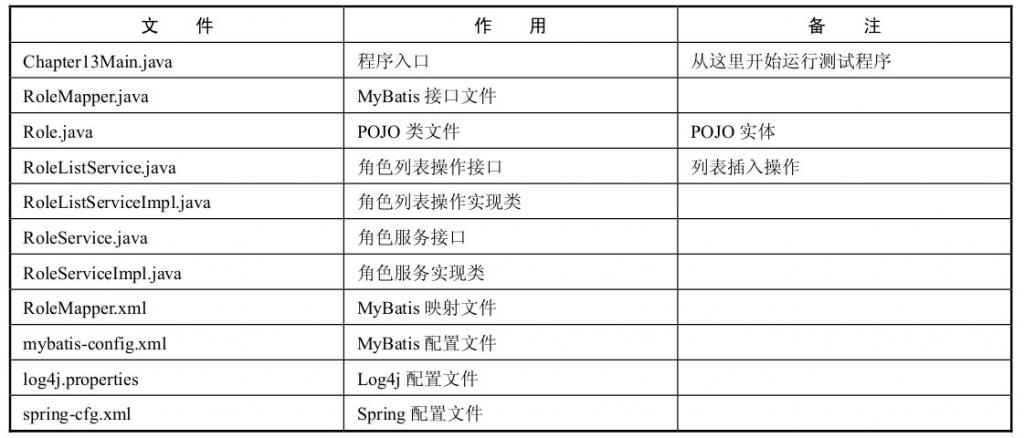通过Spring和MyBatis的组合,给出一个较为详细的实例


代码清单:配置Spring+MyBatis测试环境
代码清单:POJO类——Role.java
代码清单:搭建MyBatis的RoleMapper.xml
代码清单:RoleMapper接口
代码清单:mybatis-config.xml
代码清单:操作角色的两个接口
代码清单:两个接口的实现类
代码清单:测试隔离级别和传播行为——Chapter13Main.java
由于保存点技术并不是每一个数据库都能支持的,所以当你把传播行为设置为NESTED时,Spring会先去探测当前数据库是否能够支持保存点技术。如果数据库不予支持,它就会和REQUIRES_NEW一样创建新事务去运行代码,以达到内部方法发生异常时并不回滚当前事务的目的。
文章来源:ssm13.6


代码清单:配置Spring+MyBatis测试环境
<?xml version='1.0' encoding='UTF-8' ?> <beans xmlns="http://www.springframework.org/schema/beans" xmlns:xsi="http://www.w3.org/2001/XMLSchema-instance" xmlns:p="http://www.springframework.org/schema/p" xmlns:aop="http://www.springframework.org/schema/aop" xmlns:tx="http://www.springframework.org/schema/tx" xmlns:context="http://www.springframework.org/schema/context" xsi:schemaLocation="http://www.springframework.org/schema/beans http://www.springframework.org/schema/beans/spring-beans-4.0.xsd http://www.springframework.org/schema/aop http://www.springframework.org/schema/aop/spring-aop-4.0.xsd http://www.springframework.org/schema/tx http://www.springframework.org/schema/tx/spring-tx-4.0.xsd http://www.springframework.org/schema/context http://www.springframework.org/schema/context/spring-context-4.0.xsd"> <!--启用扫描机制,并指定扫描对应的包--> <context:annotation-config/> <context:component-scan base-package="com.ssm.chapter13.*"/> <!-- 数据库连接池 --> <bean id="dataSource" class="org.apache.commons.dbcp.BasicDataSource"> <property name="driverClassName" value="com.mysql.cj.jdbc.Driver"/> <property name="url" value="jdbc:mysql://localhost:3306/springmvc?useSSL=false&serverTimezone=Hongkong&characterEncoding=utf-8&autoReconnect=true"/> <property name="username" value="root"/> <property name="password" value="123456"/> <property name="maxActive" value="255"/> <property name="maxIdle" value="5"/> <property name="maxWait" value="10000"/> </bean> <!-- 集成MyBatis --> <bean id="SqlSessionFactory" class="org.mybatis.spring.SqlSessionFactoryBean"> <property name="dataSource" ref="dataSource"/> <!--指定MyBatis配置文件--> <property name="configLocation" value="classpath:ssm/chapter13/mybatis-config.xml"/> </bean> <!-- 事务管理器配置数据源事务 --> <bean id="transactionManager" class="org.springframework.jdbc.datasource.DataSourceTransactionManager"> <property name="dataSource" ref="dataSource"/> </bean> <!-- 使用注解定义事务 --> <tx:annotation-driven transaction-manager="transactionManager"/> <!-- 采用自动扫描方式创建mapper bean --> <bean class="org.mybatis.spring.mapper.MapperScannerConfigurer"> <property name="basePackage" value="com.ssm.chapter13"/> <property name="SqlSessionFactory" ref="SqlSessionFactory"/> <property name="annotationClass" value="org.springframework.stereotype.Repository"/> </bean> </beans>
代码清单:POJO类——Role.java
package com.ssm.chapter13.pojo; public class Role { private Long id; private String roleName; private String note; }
代码清单:搭建MyBatis的RoleMapper.xml
<?xml version="1.0" encoding="UTF-8" ?> <!DOCTYPE mapper PUBLIC "-//mybatis.org//DTD Mapper 3.0//EN" "http://mybatis.org/dtd/mybatis-3-mapper.dtd"> <mapper namespace="com.ssm.chapter13.mapper.RoleMapper"> <insert id="insertRole" parameterType="com.ssm.chapter13.pojo.Role"> insert into t_role (role_name, note) values (#{roleName}, #{note}) </insert> </mapper>
代码清单:RoleMapper接口
package com.ssm.chapter13.mapper; import com.ssm.chapter13.pojo.Role; import org.springframework.stereotype.Repository; @Repository public interface RoleMapper { public int insertRole(Role role); }
代码清单:mybatis-config.xml
<?xml version="1.0" encoding="UTF-8"?> <!DOCTYPE configuration PUBLIC "-//mybatis.org//DTD Config 3.0//EN" "http://mybatis.org/dtd/mybatis-3-config.dtd"> <configuration> <!-- 指定映射器路径 --> <mappers> <mapper resource="ssm/chapter13/mapper/RoleMapper.xml"/> </mappers> </configuration>
代码清单:操作角色的两个接口
public interface RoleService { public int insertRole(Role role); } public interface RoleListService { public int insertRoleList(List<Role> roleList); }
代码清单:两个接口的实现类
@Service public class RoleServiceImpl implements RoleService { @Autowired private RoleMapper roleMapper; @Override @Transactional(propagation = Propagation.REQUIRES_NEW, isolation = Isolation.READ_COMMITTED) public int insertRole(Role role) { return roleMapper.insertRole(role); } } @Service public class RoleListServiceImpl implements RoleListService { Logger log = Logger.getLogger(RoleListServiceImpl.class); @Autowired private RoleService roleService; @Override @Transactional(propagation = Propagation.REQUIRED, isolation = Isolation.READ_COMMITTED) public int insertRoleList(List<Role> roleList) { int count = 0; for (Role role : roleList) { try { count += roleService.insertRole(role); } catch (Exception ex) { log.info(ex); } } return count; } }
代码清单:测试隔离级别和传播行为——Chapter13Main.java
public class Chapter13Main { public static void main(String[] args) { ApplicationContext ctx = new ClassPathXmlApplicationContext("ssm/chapter13/spring-cfg.xml"); RoleListService roleListService = ctx.getBean(RoleListService.class); List<Role> roleList = new ArrayList<Role>(); for (int i = 1; i <= 2; i++) { Role role = new Role(); role.setRoleName("role_name_" + i); role.setNote("note_" + i); roleList.add(role); } int count = roleListService.insertRoleList(roleList); System.out.println(count); } }
文章来源:ssm13.6